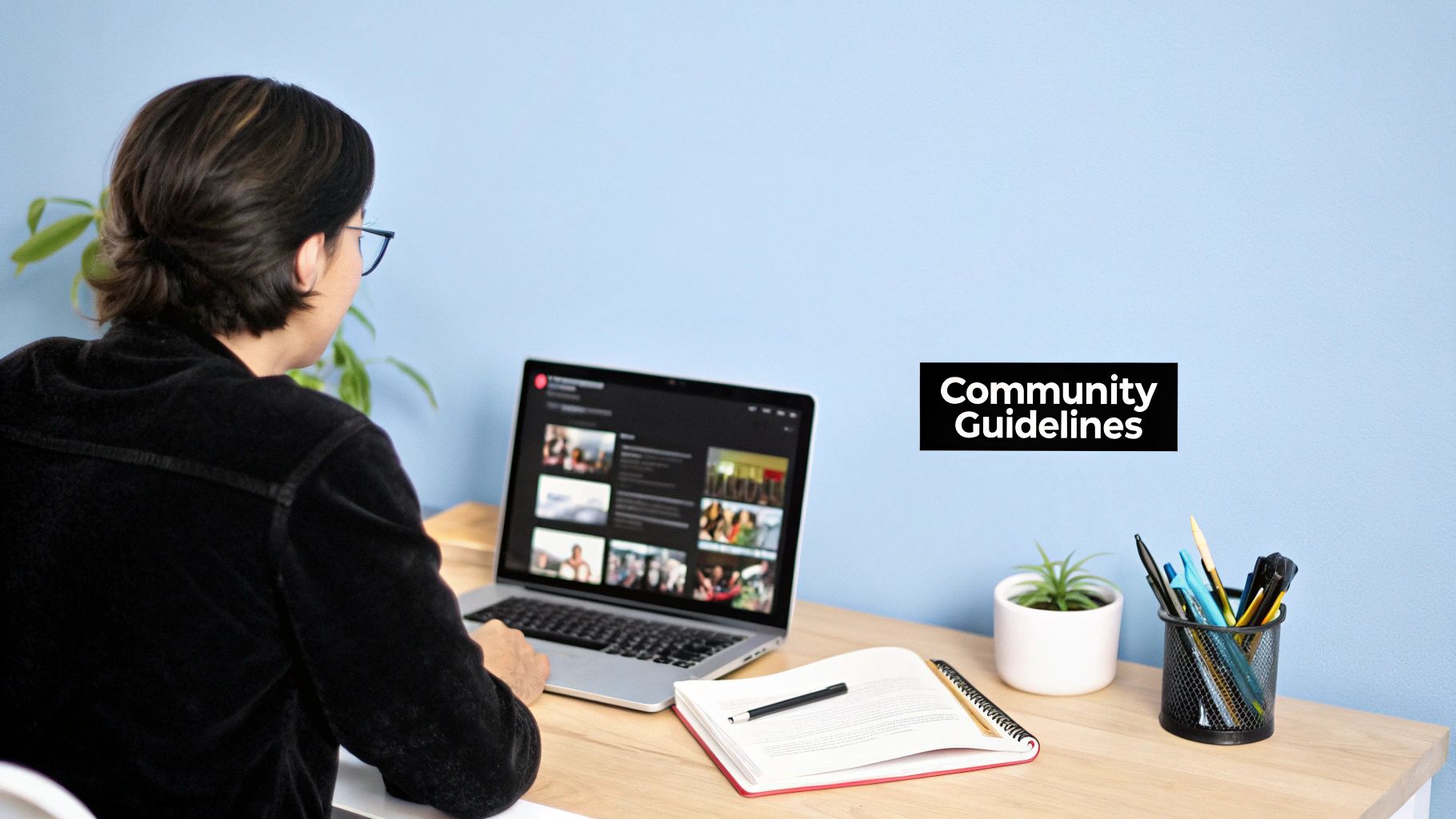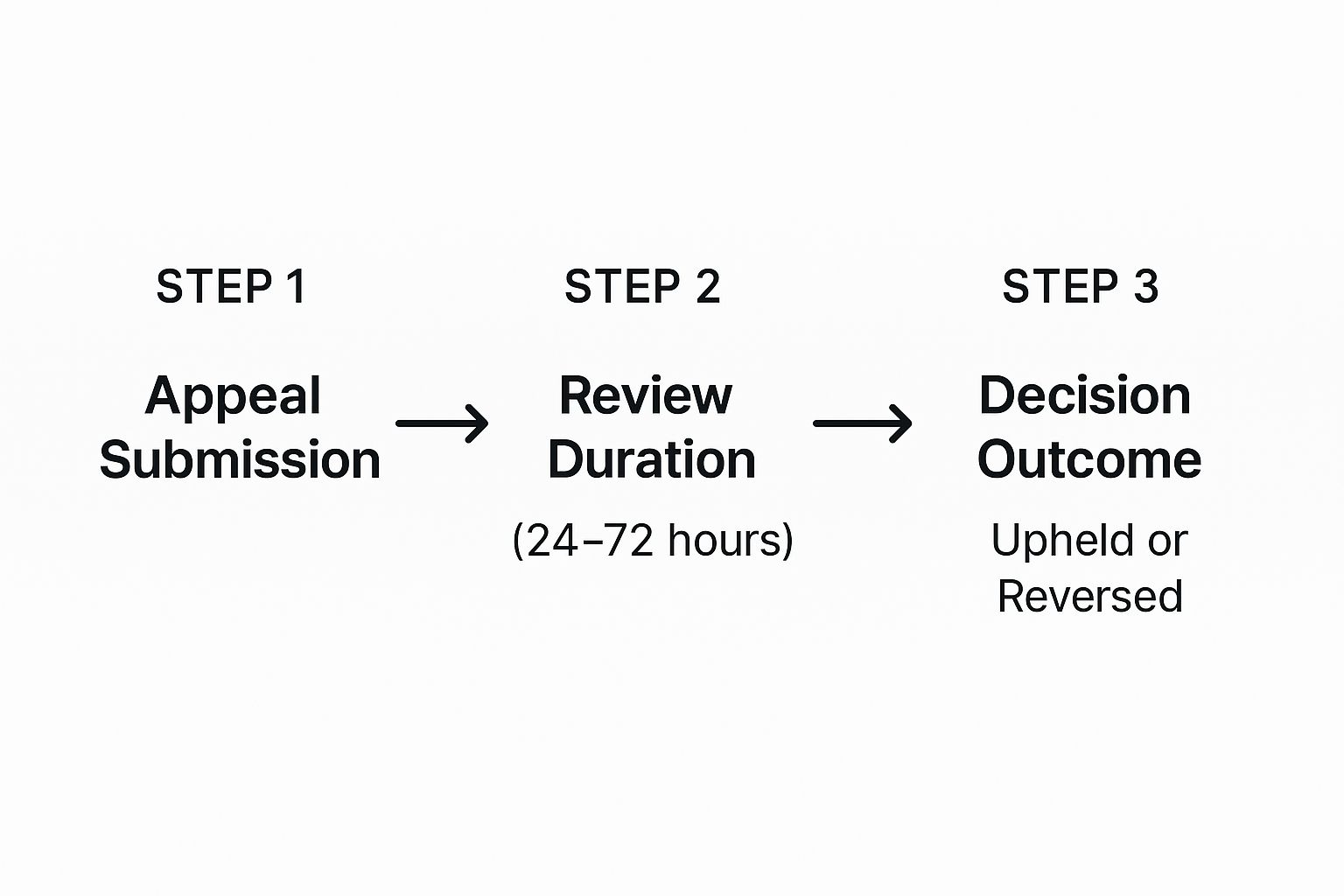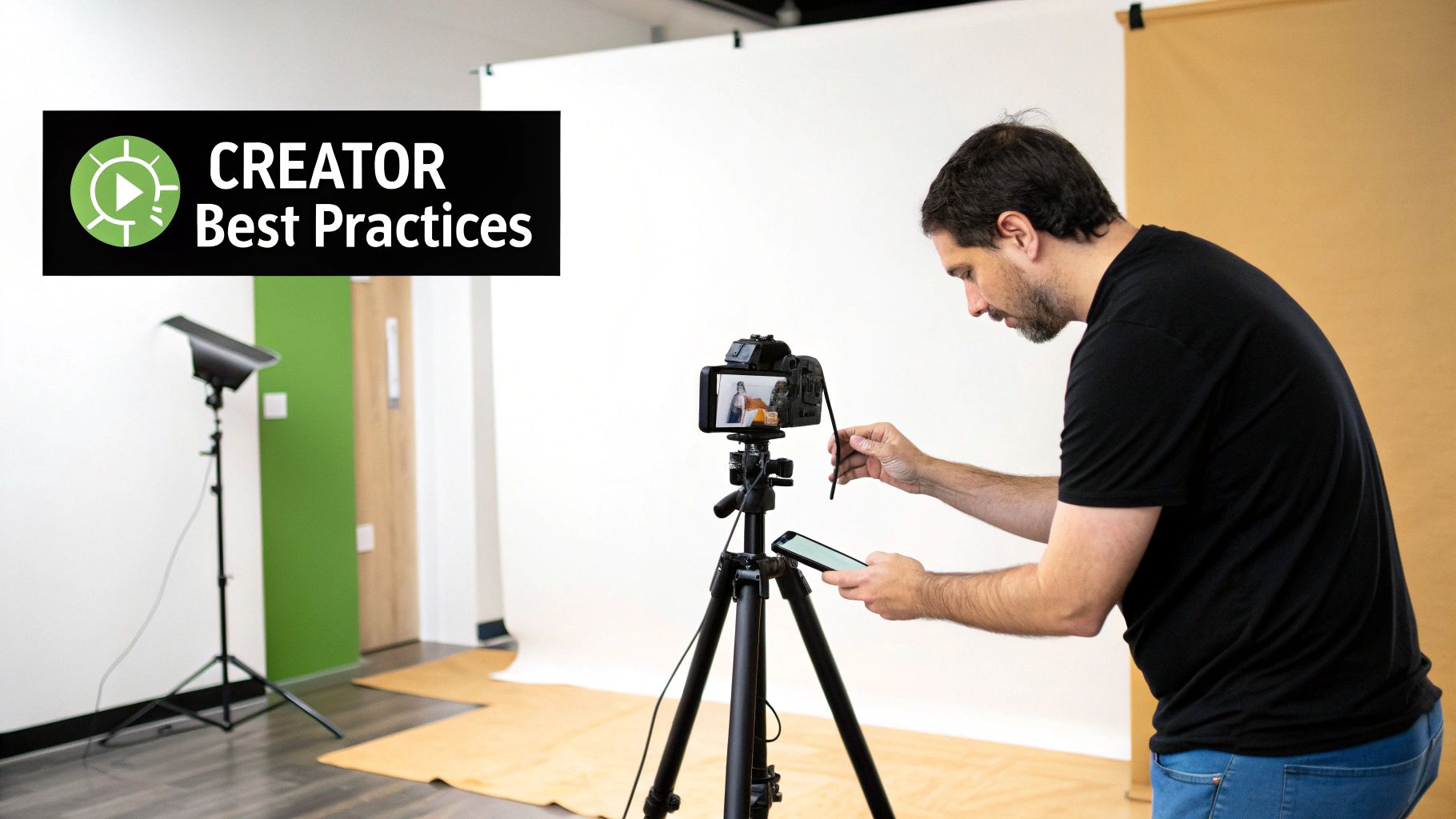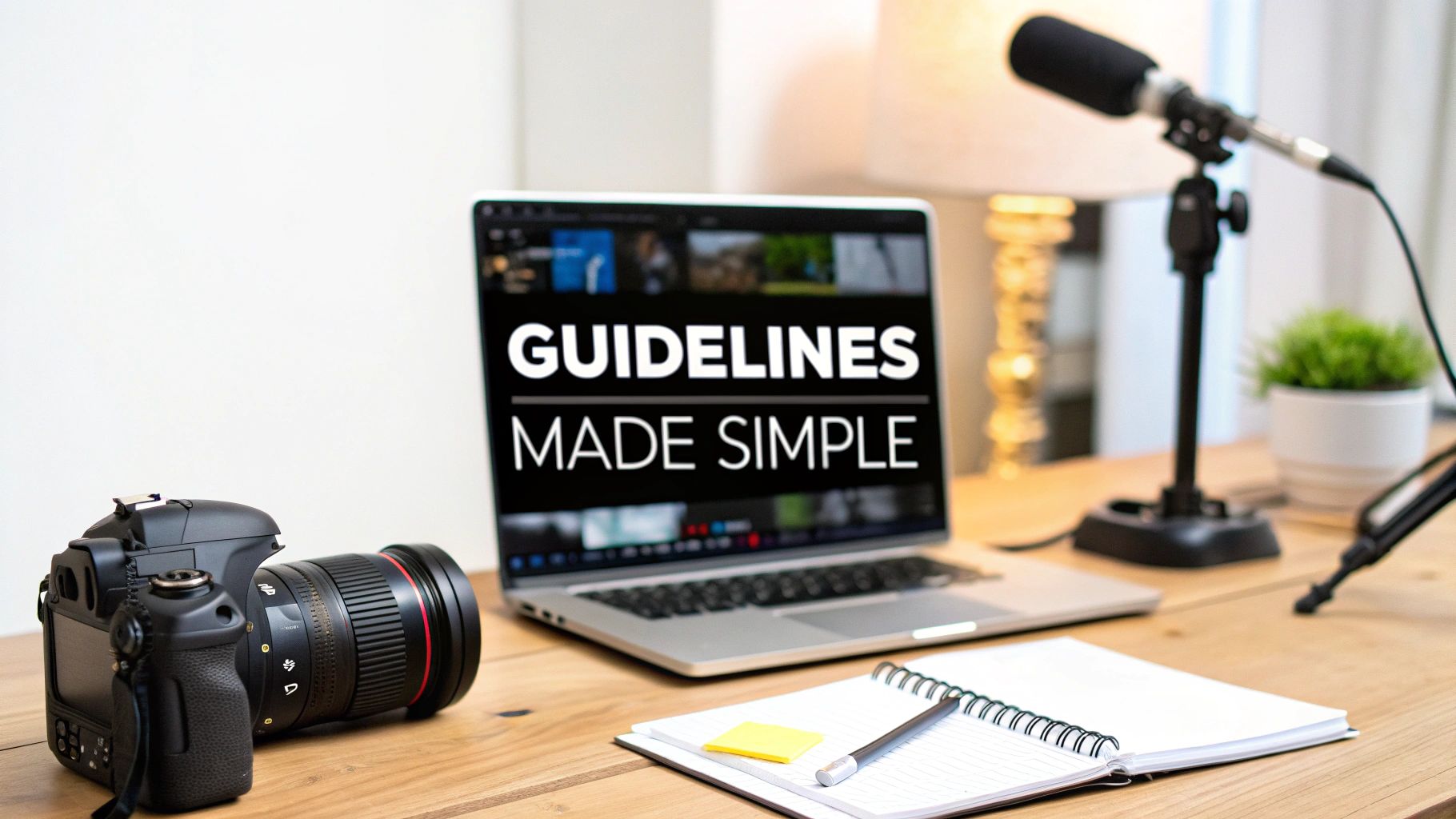Think of YouTube's Community Guidelines as the unwritten rules of a neighborhood park. They’re there to make sure everyone can have a good time without anyone getting hurt or ruining the space for others. These policies define what's allowed on the platform and apply to everything you upload—videos, comments, links, and even thumbnails.
Why the Community Guidelines Are Your Best Friend

Let’s be honest, staring at the official YouTube Community Guidelines can feel like reading a dense legal document. It’s easy to see them as just a long list of restrictions designed to catch you slipping up.
But what if you reframed that thinking? What if you saw them not as a barrier, but as the blueprint for building a successful, long-lasting channel?
Think of the guidelines less like a strict rulebook and more like the shared agreements that keep a community vibrant and sustainable. Their entire purpose is to foster a safe space where creativity can actually thrive—protecting you, your audience, and the whole creator ecosystem from harmful content.
The Core Pillars of Protection
At a high level, the guidelines are built on a few key principles. Once you get the "why" behind the specific rules, they become much easier to remember and follow. They aren't just random, disconnected policies; they fit into a few major categories.
To give you a bird's-eye view, here's a quick breakdown of the main pillars that hold up YouTube's entire safety framework.
Core Pillars of YouTube's Community Guidelines
| Guideline Category | What It Covers | Why It Matters for Creators |
|---|---|---|
| Spam & Deceptive Practices | Fake engagement, impersonation, scams, and misleading links or thumbnails. | Builds trust with your audience by ensuring your growth and interactions are genuine. Protects your channel's reputation. |
| Sensitive Content | Nudity, self-harm, suicide, and other mature themes that may not be suitable for all viewers. | Protects vulnerable audiences (especially minors) and ensures advertisers feel safe placing ads on your content, which directly impacts monetization. |
| Violent or Dangerous Content | Hate speech, harassment, cyberbullying, harmful pranks, and incitement to violence. | Creates a positive community around your channel. Prevents real-world harm and keeps your comments section from becoming toxic. |
| Regulated Goods | Content promoting the sale of firearms, illegal drugs, and other controlled items. | Keeps your channel compliant with legal regulations and prevents it from being associated with illegal activities, which could lead to termination. |
| Misinformation | Harmful misinformation related to elections, medical advice, and other high-stakes topics. | Upholds the integrity of the platform and protects your credibility as a creator. Spreading false info can erode viewer trust instantly. |
These pillars aren't just abstract ideas—they're the foundation that allows millions of creators to build careers on the platform. You can learn more about how YouTube frames these foundational policies to see the bigger picture.
For creators, mastering these rules isn't about avoiding punishment; it's about building trust. When your audience knows your channel is a reliable and safe space, they are more likely to subscribe, engage, and become loyal supporters.
Ultimately, internalizing the spirit of the YouTube Community Guidelines transforms your mindset. Instead of asking, "Will this get me a strike?" you start asking, "Does this contribute positively to my community?" That simple shift is the key to building a channel that not only survives but thrives.
How YouTube's Rules Have Evolved for Creators

YouTube didn’t start out as the polished, structured platform we see today. In its early days, the rules were much looser—think of it as a digital "wild west" where creators were constantly pushing the limits of what was possible. It was a time of explosive creativity, but it also came with huge challenges around safety and consistency.
Understanding the history of the YouTube Community Guidelines is more than just a trip down memory lane. It gives you the backstory, the "why" behind the rules that exist today. These guidelines aren't set in stone; they're a living document, always adapting to new tech, world events, and—most importantly—feedback from creators like you.
From Open Frontier to Structured Community
In the beginning, YouTube was all about growth. The policies were simple, mostly focused on the obvious stuff like copyright theft and illegal content. But as the platform exploded into a global cultural phenomenon, it ran into complex problems its original, bare-bones rules just couldn't handle.
A few pivotal moments really started to shape the robust policies we have now. Viral misinformation campaigns, major concerns over child safety, and creator burnout all acted as catalysts for change. YouTube quickly realized that to keep its ecosystem healthy, it had to stop reacting to problems and start getting ahead of them.
This shift reveals a core truth every creator should know: YouTube's number one goal is to keep the platform safe for users and advertisers. When you get that, you can align your content strategy with where the platform is headed long-term.
One of the biggest turning points came in the mid-to-late 2010s when extremism and harmful content became a massive issue. In June 2017, YouTube rolled out huge updates to its algorithm and guidelines to specifically target extremist content, using new machine learning systems to automatically flag and pull down videos promoting violence. You can find more details on how YouTube has changed over the years to stay ahead of these challenges.
Key Milestones in Guideline Evolution
Several key developments show just how much YouTube’s approach to governance has matured, directly impacting how creators operate today.
- The Rise of Machine Learning: Bringing advanced AI into the review process was a total game-changer. It allowed YouTube to screen content at a scale that would be impossible for human moderators alone, though it did create new challenges with understanding context and nuance.
- The "Adpocalypse" and Monetization Policies: When advertisers started pulling their money after seeing ads on offensive videos, YouTube was forced to get serious about its advertiser-friendly content guidelines. This directly tied community standards to a creator's wallet, making compliance a business must-do.
- Combating Harassment: The decision to hide public dislike counts wasn't random; it was a direct response to feedback about targeted harassment and "dislike mobs." This move showed a willingness to make big product changes to protect the well-being of creators.
- A Focus on Responsibility: More recently, leadership has doubled down on the platform's four "Rs" of responsibility—Remove, Raise, Reduce, and Reward. This framework guides how YouTube handles borderline content that doesn't technically break the rules but could still be harmful. You can learn more about this by exploring our post on the responsibilities of YouTube’s Chief Business Officer and their part in shaping these policies.
This journey makes one thing crystal clear: the guidelines will keep evolving. By understanding what’s driving these changes, you can build a channel that's not just successful today, but resilient enough for whatever comes next.
Decoding the Rules That Trip Up Most Creators
While the big-picture ideas in the YouTube Community Guidelines seem simple enough, it’s the little details that can land you in hot water. Certain policies are notoriously tricky, creating unintentional traps for even the most careful creators. Let's get past the basics and really break down the specific rules where people mess up most often.
Think of it like learning to drive. Everyone knows speeding is bad, but understanding the subtleties—like who has the right-of-way at a four-way stop—is what makes you a good driver instead of a liability. It's the same on YouTube. Mastering these nuances is how you protect your channel.
The Fine Line Between Education and Promotion
One of the slipperiest slopes is harmful or dangerous content. Imagine a documentarian exploring the history behind a dangerous online challenge. That’s educational. Now imagine a creator filming themselves doing that same challenge, even with a "don't try this at home" warning. That could easily be seen as promotion.
The deciding factor here is context and intent. Your video’s purpose must be to educate, document, or condemn the harmful act, not just show it off for shock value.
The core question YouTube's reviewers will ask is: "Does this video encourage dangerous behavior, or does it inform the viewer about it from a safe distance?" Your framing, commentary, and purpose make all the difference.
Misinformation in High-Stakes Arenas
YouTube takes a hard line against misinformation, especially when it comes to sensitive topics like medicine, elections, and major world events. Sharing unproven medical advice or pushing conspiracy theories about civic processes can get you a strike—fast. The platform isn't trying to shut down discussion; it's trying to prevent real-world harm.
This didn't happen overnight. YouTube’s approach to moderation has been evolving since it launched in 2005, constantly balancing new technology with the pressures of its massive scale. For example, early copyright headaches led to the Content Verification Program in 2006, and the 2021 decision to hide dislike counts was a direct response to creator feedback on harassment. You can learn more about YouTube’s policy evolution on Wikipedia to see how these rules have been shaped over time.
When Satire Crosses into Harassment
Humor is subjective, but harassment isn't. Satire and criticism are definitely protected, but they cross a line when they devolve into malicious personal attacks, prolonged bullying, or content that incites your audience to harass someone.
A comedian roasting a public figure’s policy decisions? That’s usually fine. A video attacking their physical appearance, telling followers to spam their social media, or leaking their private info? That's a clear violation. The golden rule is to critique the idea, not attack the person.
The Hidden Dangers in Your Metadata
So many creators pour all their energy into the video itself, completely forgetting that the guidelines apply to everything—your titles, descriptions, tags, and thumbnails included.
- Misleading Thumbnails: Using a thumbnail that has zero to do with your video is a classic mistake. Think putting a clickbait image of a massive explosion on a simple cooking tutorial. That’s a no-go.
- Tag Stuffing: Cramming a bunch of irrelevant keywords into your description or tag field just to game the search results is considered spam and can tank your channel's reputation with the algorithm.
- Deceptive External Links: This one’s a big deal. Linking to malware, phishing sites, or other sketchy places in your description is strictly forbidden and can get your channel terminated on the spot.
Getting your metadata right is a huge part of staying compliant, but it’s also key for growth. For a deeper look, check out our guide on how to properly implement SEO for YouTube to get more views without bending the rules.
To help you stay on the right track, here’s a quick-glance table of common violations and how to steer clear of them.
Common Guideline Violations and How to Avoid Them
| Policy Area | Common Mistake | Proactive Tip for Compliance |
|---|---|---|
| Harmful/Dangerous Content | Replicating a risky trend for views, even with a disclaimer. | Frame your video as a documentary or educational piece. Focus on the "why" behind the danger, not the act itself. |
| Misinformation (Medical) | Sharing "miracle cures" or advice that contradicts expert consensus. | Always cite credible sources like the WHO or CDC. Avoid making definitive medical claims; stick to sharing information. |
| Harassment | Making a video that attacks a person's character or appearance instead of their ideas. | Keep criticism focused on public actions or words. Never encourage your audience to engage in off-platform harassment. |
| Spam & Deceptive Practices | Using a shocking or irrelevant thumbnail to trick people into clicking. | Ensure your thumbnail, title, and video content are all aligned. What you promise is what you should deliver. |
| Child Safety | Featuring minors in situations that could be misinterpreted as dangerous or suggestive. | Review the child safety policy carefully. Ensure any content with children is unambiguously safe and appropriate. |
By familiarizing yourself with these frequent problem spots, you can make smarter, more proactive decisions. Analyzing your own content through this lens is one of the best ways to protect your work and keep your channel healthy for the long run.
What Happens When You Get a Strike
That email notification lands in your inbox, and your heart sinks. "Community Guidelines violation." It’s a gut-wrenching moment for any creator, sparking an instant wave of panic. But the absolute best thing you can do right now is take a breath, stay calm, and approach this strategically—not emotionally.
Think of YouTube's system like a learning curve. For a first-time mistake, YouTube usually gives you a simple warning. This isn't a strike. It comes with zero penalties beyond removing the video in question. It’s a one-time "heads-up" to help you learn the rules, and it stays on your channel permanently as a record.
Understanding the Three-Strike System
If you get flagged again after that initial warning, you’ve officially entered the three-strike system. Each strike brings tougher penalties and automatically expires after 90 days—as long as you don’t get another one in that window.
Here’s how it all breaks down:
- First Strike: Your channel is essentially put in a one-week timeout. You won’t be able to upload new videos, go live, or create posts in the Community tab. After the seven days are up, everything goes back to normal, but that strike hangs around on your channel for the full 90 days.
- Second Strike: If you receive a second strike within the same 90-day period as your first, the consequences get steeper. This time, you're blocked from posting any new content for two weeks. Just like before, the strike will expire 90 days from the day it was issued.
- Third Strike: This is the one you want to avoid at all costs. A third strike within any 90-day window means your channel will be permanently terminated from YouTube. Game over.
This whole system is designed to give creators a few chances to get it right before they face the ultimate penalty of losing their channel for good.
How to Navigate the Appeals Process
Just because your video was flagged doesn't mean the decision is final. Let’s be real—both automated bots and human reviewers can make mistakes, especially when content requires a bit of nuance or context to understand. If you genuinely believe your video played by the rules, you have every right to appeal.
Think of the appeals process as your chance to ask for a second opinion. When you submit an appeal, a different human reviewer takes a fresh look at your video and the original flag. You only get one shot to appeal each strike, so you have to make it count.
This infographic breaks down the simple, three-step flow of the appeals process.

As you can see, it’s a pretty straightforward path, and you’ll usually get a decision within a few days.
When you write your appeal, be polite, concise, and get straight to the point. Explain why you believe your video follows YouTube's Community Guidelines. If your video covers a sensitive topic for educational or documentary purposes, make that intent crystal clear. Ditch the emotional pleas and stick to the facts about your content and the specific policy in question.
Key Takeaway: A winning appeal is all about providing the context that the first review might have missed. Build your argument around the policies themselves, not how you feel about the strike.
If you win your appeal, the strike gets wiped from your record and your video is put back up. If it’s denied, the strike and its penalties stick. Unfortunately, once an appeal is denied, that's the end of the road. While getting a strike is always a bit scary, a solid, well-argued appeal is your best bet for fixing a mistake. As you plan your next move, it might be a good time to check out our guide on fresh videos ideas for YouTube that are great for staying on the platform's good side.
A Proactive Strategy to Protect Your Channel

True compliance with the YouTube Community Guidelines isn't about nervously tiptoeing around the rules. It's about building a content workflow that has safety and awareness baked in from the very beginning.
Making the shift from a reactive mindset ("I hope this doesn't get a strike") to a proactive one ("I know this is compliant") is the single best way to protect your channel for the long haul. This means weaving guideline awareness into every stage of your creative process—from brainstorming and scripting all the way to post-upload analysis.
When you do your homework upfront, you can tackle sensitive topics responsibly, design compelling yet safe thumbnails, and build a powerful, long-term defense for your channel's health.
Research and Frame Sensitive Topics Responsibly
Many creators get strikes not because their topic is forbidden, but because their framing lacks the necessary context. YouTube's automated systems are great at spotting potentially problematic content, but they often struggle with nuance. It's your job to provide that nuance clearly and upfront.
Before you even think about hitting record on a controversial subject, you need to research how established, successful channels in your niche handle it. This is where tools can turn raw data into a concrete strategy.
For instance, an educator or researcher could use a YouTube Transcript Extractor to analyze how top creators discuss sensitive issues. By pulling their scripts, you can quickly identify the exact language, disclaimers, and contextual framing they use to stay well within the guidelines. This provides a blueprint for discussing difficult topics in a way that prioritizes educational value and dramatically lowers the risk of automated flags.
The goal here is to provide undeniable Educational, Documentary, Scientific, or Artistic (EDSA) value. When a human reviewer eventually looks at your video, your intent should be unmistakable. Clear verbal disclaimers, on-screen text citing your sources, and a focus on analysis over shock value are your best friends.
Design Compliant and Compelling Visuals
Your thumbnail is the very first thing a viewer—and just as importantly, YouTube's algorithm—sees. It's also a common minefield for unintentional guideline violations, especially when it comes to sensitive or violent imagery. A proactive approach means studying what works in your niche without crossing the line.
A great way to start is by using the YouTube Thumbnail Downloader to gather a collection of thumbnails from top-performing videos on your topic. This creates an invaluable mood board for inspiration and helps you understand the visual language of your space.
Once you have a feel for what’s working, you can create your own compliant designs. A tool like the YouTube Thumbnail Studio lets you build compelling, high-quality thumbnails with professional features like layers and custom fonts, ensuring your visuals are both click-worthy and safe. This process transforms thumbnail creation from a risky guess into a data-informed decision.
Monitor and Adapt Based on Audience Feedback
Finally, your responsibility doesn't end the moment you hit "publish." A crucial part of any proactive strategy is keeping a close eye on your channel's health and listening to what your audience is saying.
The YouTube Channel Analytics tool can offer deep insights into audience sentiment and engagement. Are viewers in the comments misunderstanding your intent? Are certain videos causing unexpected drops in viewership? Monitoring these metrics helps you spot potential fires before they escalate into official warnings or strikes, allowing you to make data-driven decisions about your content strategy.
This continuous feedback loop—researching, creating, and monitoring—is the bedrock of a resilient channel. It also ensures you're building a sustainable business. To learn more about that, check out our detailed guide on the fundamentals of monetization for YouTube and see how compliance directly impacts your bottom line.
Answering Your Top Guideline Questions
Even the most careful creators run into tricky situations where the YouTube Community Guidelines feel a bit murky. Knowing how to handle these moments isn't just good practice—it's essential for protecting your channel. Let's clear up some of the most common questions that pop up.
What Is the Difference Between a Community Guidelines and a Copyright Strike?
This one trips up a ton of creators, but the distinction is critical. Think of it as the difference between breaking house rules and breaking the law.
- A Community Guidelines strike comes directly from YouTube. It means you've broken one of their platform-specific rules—things like spam, harassment, or dangerous content. This is all handled internally through YouTube's three-strike system.
- A copyright strike, on the other hand, is a formal legal takedown request. It’s filed by an outside party who claims you've used their content without permission. This isn't about YouTube's rules; it's a legal issue that falls under the DMCA (Digital Millennium Copyright Act).
While both can seriously damage your channel, they originate from different places and have completely separate appeal processes. You can't treat them the same way.
Can I Get a Strike for an Old Video?
Yes, you absolutely can. A video you posted years ago isn't safe just because it's old. If it violates current policies, it can still be flagged and taken down.
YouTube’s systems are always scanning everything on the platform, not just the new stuff. This is why it’s a great idea to periodically audit your own back catalog of videos, especially after major policy updates. What was perfectly fine in 2015 might be a clear violation today.
How Can I Discuss Sensitive Topics Without Getting a Strike?
This is all about context. When you're tackling a tough subject, your goal has to be providing what YouTube calls EDSA value: Educational, Documentary, Scientific, or Artistic. Your intent has to be crystal clear—you're here to inform, not to shock or promote harmful acts.
When it comes to sensitive content, your framing is everything. The line between a policy violation and protected educational content often boils down to the context you build with your narration, on-screen text, and overall presentation.
Here are a few practical ways to stay on the right side of that line:
- Use On-Screen Disclaimers: Kick off your video with a clear disclaimer explaining the educational or documentary nature of what you're about to show.
- Cite Credible Sources: Ground your discussion in facts by referencing reputable studies or organizations. This signals to reviewers that your intent is to inform.
- Focus on Analysis, Not Glorification: Your commentary is crucial. Frame your content to analyze or condemn the sensitive issue rather than just showing it without comment.
By building this framework into your video, you give both the automated systems and human reviewers the signals they need to understand your true purpose.
Ready to build a safer, smarter workflow for your channel? The free tools from YouTube Navigator can help you research topics, design compliant thumbnails, and analyze your performance to stay ahead of the curve. Get started today at https://youtubenavigator.com and give your channel the protection it deserves.
